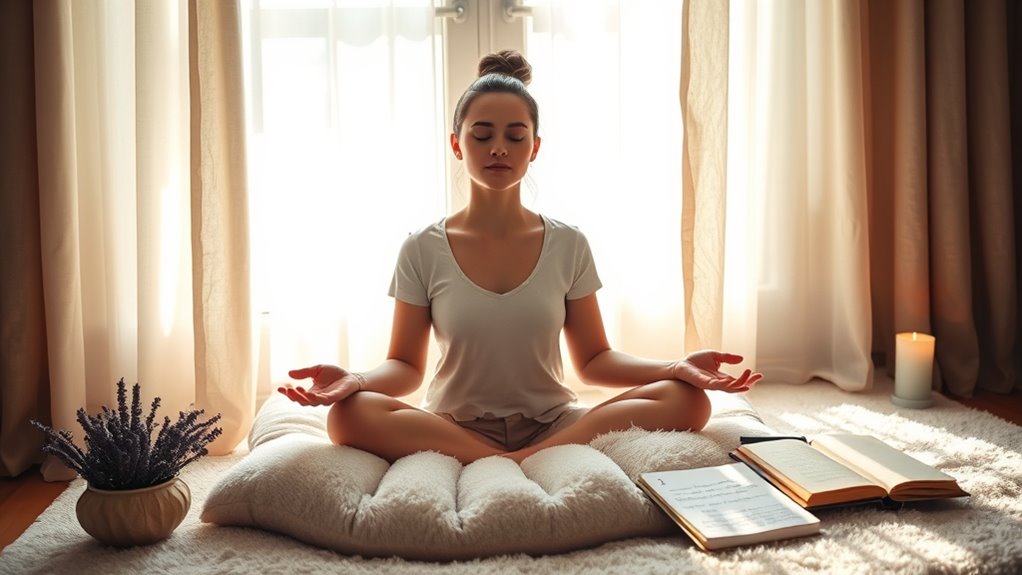Transforming anxiety with guided meditation scripts involves creating a calm, safe space where you can focus on your breath and bodily sensations without judgment. These scripts use gentle instructions, visualizations, and affirmations to help rewire your brain’s response to stress, promoting relaxation and emotional resilience. Regular practice can shrink the fear centers and strengthen calming areas, making anxiety easier to manage over time. Keep exploring to discover how you can craft personalized scripts that suit your needs.
Key Takeaways
- Guided meditation helps reduce anxiety by promoting present-moment awareness and emotional regulation techniques.
- Creating a safe, comfortable environment enhances the effectiveness of meditation practices for anxiety relief.
- Regular mindfulness practice can physically alter brain regions, decreasing fear responses and increasing calmness.
- Scripts should incorporate simple instructions, calming phrases, and visualization to deepen relaxation and emotional resilience.
- Personalizing meditation scripts with meaningful imagery and affirmations enhances their impact on anxiety transformation.
Understanding How Guided Meditation Alleviates Anxiety

Guided meditation alleviates anxiety by helping you become more aware of your emotional and physical states without judgment. As you follow a script, you learn to observe your feelings and sensations objectively, creating mental space from overwhelming thoughts. This process reduces the intensity of anxiety, allowing you to respond calmly instead of reacting impulsively. By focusing on your breath and bodily awareness, you strengthen your ability to stay present. Incorporating mindfulness techniques into your practice can further enhance relaxation and emotional balance. Developing emotional resilience through consistent practice also helps you better cope with stressors in daily life. Resources and tools like guided meditation provide a supportive, structured way to manage anxiety, fostering inner calm and emotional stability.
The Science Behind Mindfulness and Brain Changes
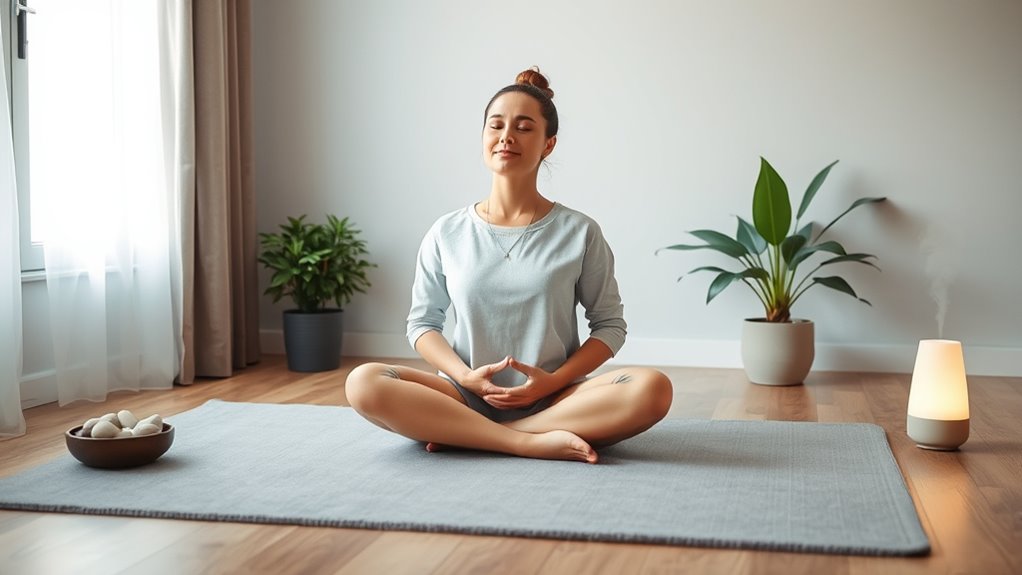
Research shows that regular mindfulness practice can lead to significant changes in your brain, especially in areas related to emotion regulation and stress response. This includes shrinking the amygdala, which reduces fear and anxiety, and strengthening the prefrontal cortex, enhancing decision-making and calmness. These changes improve your ability to manage stress and emotional reactions. The table below highlights key brain regions affected: brain plasticity, demonstrating the brain’s remarkable ability to adapt through mindfulness practices. Additionally, engaging in mindfulness enhances neuroplasticity, allowing the brain to reorganize itself beneficially over time. Studies also suggest that mindfulness can promote emotional resilience, helping individuals better cope with daily stressors. Furthermore, ongoing practice can foster cognitive flexibility, supporting better problem-solving and adaptability in challenging situations.
Creating a Safe Space for Meditation Practice

Creating a safe space for meditation practice is essential for fostering relaxation and openness. Choose a quiet, comfortable environment where you won’t be disturbed. Dim the lights or use soft lighting to create a calming atmosphere. Use cushions, blankets, or a chair to support your body comfortably. Minimize distractions by turning off notifications and setting boundaries. Incorporate gentle sounds, like soft music or nature noises, if it helps you feel secure. Trust your surroundings and focus on the present moment. When you feel safe, it’s easier to relax, explore your thoughts, and deepen your meditation practice without fear or tension. Understanding residency requirements and other legal considerations can also help you establish a stable foundation for your practice. Creating a peaceful environment can significantly enhance your ability to meditate effectively and consistently. Additionally, maintaining privacy and security in your space can promote greater peace of mind during meditation. Incorporating organized and clutter-free spaces aligns with the principles of mindful decluttering and can further support your meditation routine by reducing visual distractions and creating a serene setting.
Essential Elements of Effective Meditation Scripts

Effective meditation scripts incorporate clear, concise language that guides your attention smoothly through each stage of the practice. To achieve this, focus on: 1. Using simple, specific instructions that prevent confusion. 2. Incorporating calming, supportive phrases to foster relaxation. 3. Structuring the script logically, progressing from awareness to deepening calm. These elements help you stay present without distraction, deepen your experience, and build trust in the process. Clear language guarantees your mind can follow effortlessly, making your meditation more effective. Keep your words gentle, direct, and purposeful to create a safe, engaging environment that supports anxiety relief. Additionally, emphasizing mindfulness techniques can enhance your focus and overall sense of well-being during meditation. Incorporating guided imagery can also help deepen relaxation and mental clarity, making your practice more impactful. Ensuring your script remains consistent throughout helps reinforce a sense of safety and predictability, which is particularly helpful when managing anxiety. Incorporating auditory cues can further support engagement and focus during your practice.
Exploring Different Guided Meditation Techniques for Anxiety
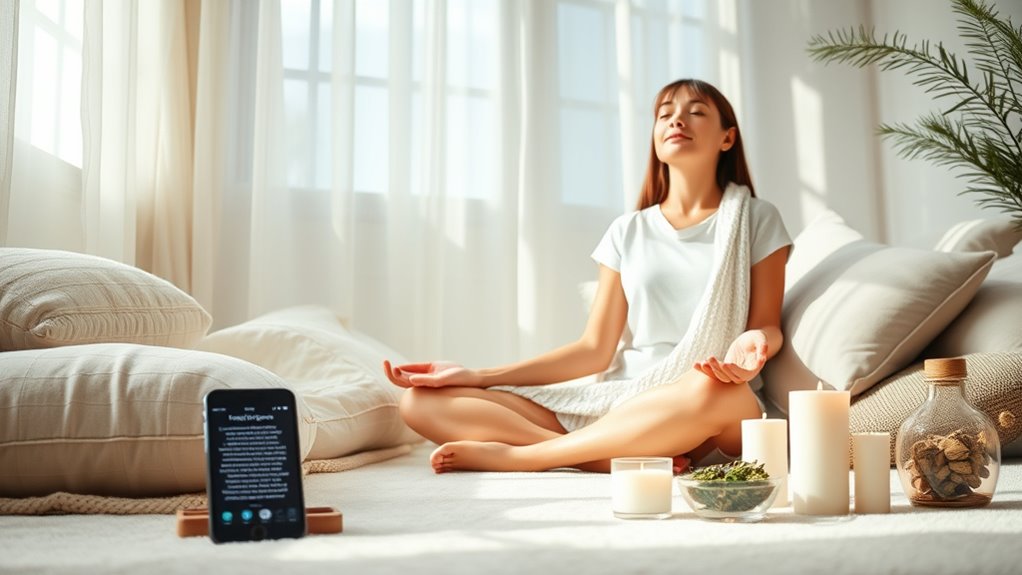
Exploring different guided meditation techniques offers a variety of approaches to manage anxiety effectively. You might try body scan meditations, where you focus on physical sensations to anchor your awareness and release tension. Alternatively, visualization techniques guide you to imagine calming scenes, promoting relaxation. Loving-kindness meditations foster self-compassion and reduce self-criticism. Breath-focused methods emphasize deep, mindful breathing to activate the parasympathetic nervous system. Movement-based practices, like gentle walking meditations, combine physical activity with mindfulness. Incorporating skincare patches into your routine can also serve as a calming ritual, providing a tactile focus that helps ground your mind. Recognizing angel numbers can serve as a powerful reminder of spiritual guidance and reassurance during anxious moments. Using relaxation techniques like progressive muscle relaxation can further enhance your sense of calm and control. In addition, practicing proper preparation by creating a quiet, comfortable environment can significantly improve the effectiveness of your meditation sessions. Each technique offers unique benefits, so experimenting helps you find what resonates best. Incorporating diverse approaches enhances your resilience and deepens your ability to calm anxiety in various situations.
Step-by-Step Guide to Using Breathwork for Calmness
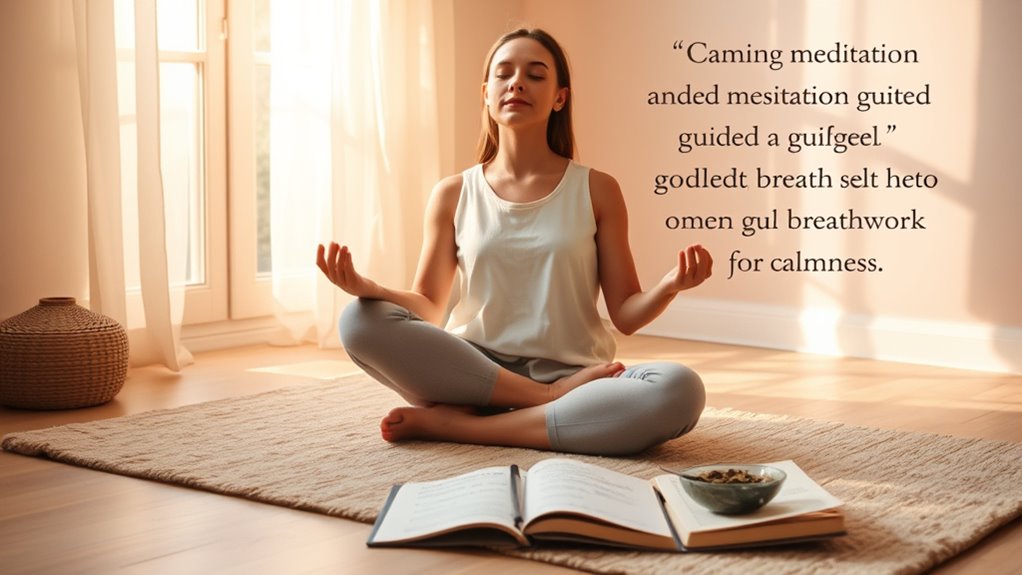
Have you ever noticed how your breath changes when you’re anxious? You might breathe shallowly, hold your breath, or breathe rapidly. To use breathwork for calmness, start by:
- Find a quiet, comfortable space.
- Close your eyes and take a slow, deep breath in through your nose.
- Exhale gently through your mouth, releasing tension.
- Practice mindful breathing techniques to enhance your relaxation and presence. Incorporating relaxation techniques can further deepen your sense of calm. Recognizing how breathwork influences your emotional regulation can help you better manage stress responses.
Repeat this cycle, focusing on the sensation of your breath. Inhale slowly, feeling your belly rise; exhale fully, noticing your belly fall. Use affirmations like “I am safe” or “Calm is here” to reinforce relaxation. Practice for a few minutes, gradually lengthening your breath for deeper serenity. Incorporating aquatic exercise can also help enhance your overall sense of calm and well-being.
Addressing Negative Thoughts Through Mindful Observation

When you focus on your breath to cultivate calm, you start to notice how thoughts often arise alongside physical sensations. Instead of chasing or resisting them, observe these thoughts with gentle curiosity. Recognize that thoughts are temporary and pass like clouds. Use mindful observation to detach from negative patterns, seeing them as passing events rather than truths. This practice helps you create space between stimulus and response, reducing anxiety’s grip.
| Thought Type | Physical Sensation | Response |
|---|---|---|
| Negative | Tight chest | Acknowledge without judgment |
| Ruminative | Tension in shoulders | Breathe into the tension |
| Worrying | Heart pounding | Label as “passing thought” |
| Self-critical | Clenched jaw | Offer compassion |
| Neutral | Relaxed muscles | Return focus to breath |
Incorporating Affirmations to Support Emotional Resilience
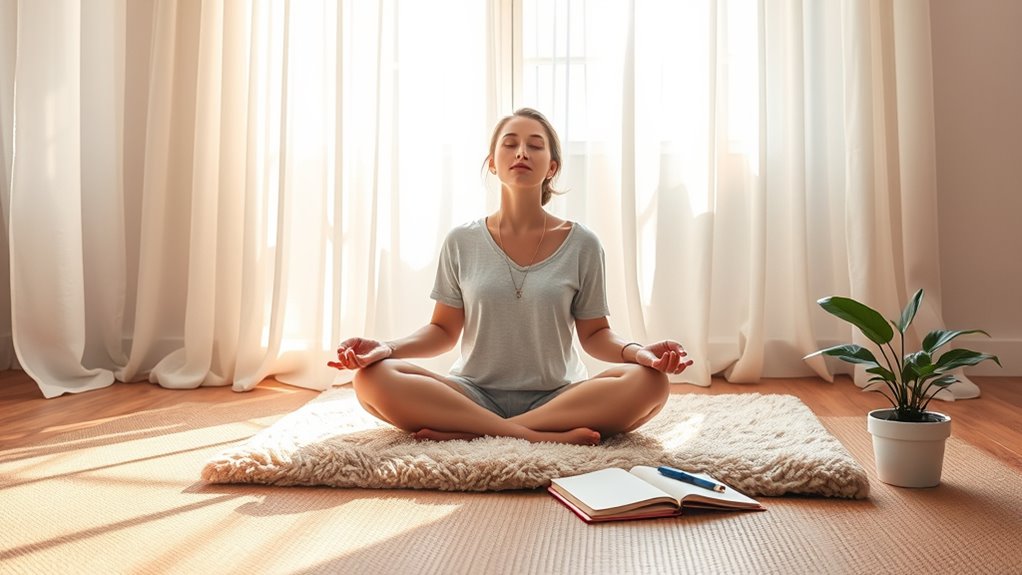
Incorporating affirmations into your mindfulness practice can markedly strengthen your emotional resilience by fostering positive self-talk and shifting focus away from worries. First, choose affirmations that resonate with you, like “I am safe,” “I am capable,” or “I am calm.” Second, repeat these affirmations during meditation to reinforce your inner strength. Third, visualize embracing these positive beliefs, allowing them to anchor you in the present moment. This process rewires your mindset, reducing anxiety’s grip and building resilience over time. Consistent use of affirmations helps you develop a compassionate, empowering inner dialogue, fostering lasting emotional stability.
Tips for Personalizing Meditation Scripts to Your Needs

Personalizing meditation scripts guarantees they resonate more deeply with your unique experiences and needs. To do this, start by identifying what triggers your anxiety and what calming words or images inspire you. Use language that feels natural and reassuring, avoiding generic phrases. Incorporate specific visualizations, sounds, or sensations that have personal significance. Adjust the script’s length and pace to match your comfort level. Remember, it’s okay to modify scripts over time as your needs evolve. The goal is to create a practice that feels authentic and supportive, making it easier to relax and connect during each session.
Resources and Templates for Crafting Your Own Guided Meditations

Are you looking for practical ways to create effective guided meditations tailored to your needs? Resources and templates make this process straightforward. First, you can access pre-designed scripts focused on anxiety relief that you can customize. Second, use worksheet templates to organize your meditation steps, affirmations, and cues. Third, explore online platforms offering adaptable audio and visual tools to enhance your recordings. These resources help streamline your practice, ensuring consistency and focus. With templates and guided frameworks, you’ll confidently craft personalized meditations that resonate deeply, fostering calm and resilience. Start with these tools to develop your unique approach and transform anxiety through mindful guidance.
Frequently Asked Questions
Can Guided Meditation Replace Therapy for Anxiety?
You might wonder if guided meditation can replace therapy for anxiety. While it’s a helpful tool that can reduce stress, improve emotional resilience, and change brain function over time, it doesn’t address underlying issues or provide personalized guidance. Therapy offers tailored support, coping strategies, and professional insights. Combining both can be most effective, giving you mindfulness benefits while also working through deeper roots of your anxiety.
How Often Should I Practice Guided Meditation for Best Results?
Practicing regularly, repeatedly, and rhythmically is key to calming your core and conquering chronic chaos. For best results, aim to meditate at least once daily—morning, noon, or night—creating a consistent, calming cadence. Even just five minutes can make a difference. Over time, your practice deepens, distress diminishes, and your inner insight ignites. So, set a schedule, stay steady, and let the mindful momentum mold your mental well-being.
Are There Specific Scripts for Severe Anxiety or Panic Attacks?
Your question about scripts for severe anxiety or panic attacks is important. Yes, there are specific guided meditation scripts designed to help during intense episodes. These scripts usually focus on grounding techniques, deep breathing, and calming visualizations to reduce panic symptoms quickly. You’ll find them helpful for regaining control and calming the mind and body. Practice them regularly so they become easier to use when you need immediate relief.
How Do I Overcome Resistance or Difficulty Focusing During Meditation?
Did you know that about 75% of people experience difficulty focusing during meditation at some point? To overcome resistance, start with short sessions and set gentle, realistic intentions. When your mind wanders, acknowledge it without judgment and gently redirect your focus to your breath or sensations. Be patient and consistent—over time, your ability to focus will improve, making meditation feel easier and more rewarding.
Can Guided Meditation Help With Long-Term Anxiety Management?
You might wonder if guided meditation can help with long-term anxiety. The answer is yes. Regular practice rewires your brain, shrinking the amygdala and reducing fear responses. It enhances emotional resilience, promotes mindfulness, and creates lasting mental health benefits. Using scripts, you can develop consistent routines that improve your ability to manage anxiety over time. With patience and persistence, guided meditation becomes a powerful tool for lasting calm and emotional stability.
Conclusion
So, congratulations—you’re now officially a meditation maestro in the battle against anxiety. Who knew that simply breathing, observing, and whispering kind words to yourself could be so revolutionary? Forget therapy bills and endless to-do lists—your new superpower is right here, in these scripts. Now go ahead, sit back, breathe deeply, and watch your worries retreat faster than your Wi-Fi during a storm. Peace, at last, and all thanks to a little mindful magic.
